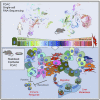Single-cell transcriptome analysis for cancer and biology of the pancreas: A review on recent progress
- PMID: 37091793
- PMCID: PMC10115972
- DOI: 10.3389/fgene.2023.1029758
Single-cell transcriptome analysis for cancer and biology of the pancreas: A review on recent progress
Abstract
Single-cell sequencing has become one of the most used techniques across the wide field of biology. It has enabled researchers to investigate the whole transcriptome at the cellular level across tissues, which unlocks numerous potentials for basic and applied studies in future diagnosis and therapy. Here, we review the impact of single-cell RNA sequencing, as the prominent single-cell technique, in pancreatic biology and cancer. We discuss the most recent findings about pancreatic physiology and pathophysiology owing to this technological advancement in the past few years. Using single-cell RNA sequencing, researchers have been able to discover cellular heterogeneity across healthy cell types, as well as cancer tissues of the pancreas. We will discuss the new immunological targets and new molecular mechanisms of progression in the microenvironment of pancreatic cancer studied using single-cell RNA sequencing. The scope is not limited to cancer tissues, and we cover novel developmental, evolutionary, physiological, and heterogenic insights that have also been achieved recently for pancreatic tissues. We cover all biological insights derived from the single-cell RNA sequencing data, discuss the corresponding pros and cons, and finally, conclude how future research can move better by utilizing single-cell analysis for pancreatic biology.
Keywords: genetic heterogeneity; pancreas biology; pancreas cancer; single-cell sequencing; transcriptome analysis.
Copyright © 2023 Tamaddon, Azimzadeh, Gifani and Tavangar.
Conflict of interest statement
PG was employed by AI VIVO Ltd. The remaining authors declare that the research was conducted in the absence of any commercial or financial relationships that could be construed as a potential conflict of interest.
Figures







Similar articles
-
Discoveries in Pancreatic Physiology and Disease Biology Using Single-Cell RNA Sequencing.Front Cell Dev Biol. 2022 Jan 24;9:732776. doi: 10.3389/fcell.2021.732776. eCollection 2021. Front Cell Dev Biol. 2022. PMID: 35141228 Free PMC article. Review.
-
Cancer biology deciphered by single-cell transcriptomic sequencing.Protein Cell. 2022 Mar;13(3):167-179. doi: 10.1007/s13238-021-00868-1. Epub 2021 Aug 17. Protein Cell. 2022. PMID: 34405376 Free PMC article. Review.
-
Advancement of single-cell sequencing for clinical diagnosis and treatment of pancreatic cancer.Front Med (Lausanne). 2023 Aug 31;10:1213136. doi: 10.3389/fmed.2023.1213136. eCollection 2023. Front Med (Lausanne). 2023. PMID: 37720505 Free PMC article. Review.
-
Single-cell network biology for resolving cellular heterogeneity in human diseases.Exp Mol Med. 2020 Nov;52(11):1798-1808. doi: 10.1038/s12276-020-00528-0. Epub 2020 Nov 26. Exp Mol Med. 2020. PMID: 33244151 Free PMC article. Review.
-
Single-cell RNA sequencing in breast cancer: Understanding tumor heterogeneity and paving roads to individualized therapy.Cancer Commun (Lond). 2020 Aug;40(8):329-344. doi: 10.1002/cac2.12078. Epub 2020 Jul 12. Cancer Commun (Lond). 2020. PMID: 32654419 Free PMC article. Review.
Cited by
-
The Impact of Cancer on Mental Health and the Importance of Supportive Services.Galen Med J. 2024 Feb 26;13:e3327. doi: 10.31661/gmj.v13i.3327. eCollection 2024. Galen Med J. 2024. PMID: 39224547 Free PMC article.
References
-
- Carstens J. L., Yang S., Correa de Sampaio P., Zheng X., Barua S., McAndrews K. M., et al. (2021). Stabilized epithelial phenotype of cancer cells in primary tumors leads to increased colonization of liver metastasis in pancreatic cancer. CellReports 35 (2), 108990. ElsevierCompany. 10.1016/j.celrep.2021.108990 - DOI - PMC - PubMed
Publication types
LinkOut - more resources
Full Text Sources
Miscellaneous

